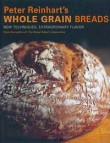Peter’s Blog, Sept. 15th, Cold Fermentation
He’s raised an interesting question: does long, cold, overnight fermentation create a flavor that would universally be considered superior; that is, an inarguable benefit? To answer this, I think, requires more than a simple yes or no, but an explanation as to what happens during the fermentation stage that would lead to the opinion that this is a way to improve flavor. We’ve discussed this here in the past, though in an abbreviated manner, so let me draw it out more completely and, hopefully, address Scott’s question at the same time.
My belief (and remember, this is just my opinion — no one owns the whole truth in these matters) is that the key to the value of long fermentation is the enzyme activity, in particular the alpha-amylase and beta-amylase action that slowly releases glucose, maltose, and other sugars from their starchy chains in the flour. This takes time, anywhere from 6 to 12 hours minimum, but it is not a biological fermentation since enzymes are not alive, they are simply part of the grain (protein fragments, but not living organisms, if I understand the chemistry of them properly, but then I’m no chemist). The process of sugar break-out from the starch is slower at colder temperatures but is not subject to the same rules as yeast and bacteria (which essentially go nearly dormant when they get cooler than 40 degrees F.). Anyway, pizza makers have known for a long time, whether by accident or intentionality, that their dough balls are better tasting and more beautiful to look at when used the following day (or even over a number of days, within reason) than if used on the same day in a fast rising method. It is not only because the fermentation is better in the slow method but, I believe, because more natural sugar has been evoked from grain by the enzymes and that improves both color and flavor, as well as providing new, ongoing food for the yeast and bacterial fermentation (so, in a way, it does elicit more fermentation flavor as well as releasing sugar). Bottom line: yes, Scott, I do believe long, cold fermentation improves flavor but, I have to say this too, it is not the only way to release flavor — that is, it is time more than coldness that is the key.
I say this because, as we discussed in the long comment thread a few weeks ago, Philippe Gosselin (and I’m sure others) uses a method that doesn’t require any yeast during the overnight period and, more importantly, pizza masters like Chris Bianco are able to achieve amazing flavor and texture by making their dough on the same day, not using any refrigeration. But in Bianco’s case, and others who can pull it off, the dough is made early enough in the day to allow the enzyme activity to occur without over-fermenting the dough by using a smaller amount of yeast. In other words, the “baking triangle” consisting of time, temperature and ingredients can be manipulated in many ways to achieve great results. Some methods and formulas might, for example, use a pre-ferment like a biga, poolish, or pate fermentee’ to add enzyme-evoked flavor in a shorter period of time.
So, to summarize, Scott123 is correct in asserting that long, cold fermentation achieves superior results to short, fast fermentation but let’s not forget the possibility of long, room temperature fermentation too, or the use of pre-ferments to shorten fermentation time (I won’t even touch the matter of commercial dough conditioners that spike the dough with added enzymes to speed things along — that’s another can of worms but one worth visiting in the future). If I’m not mistaken, Jim Lahey uses the room temperature method in his so-called “NY Times French Bread” method (and I believe also in his pizza dough — BTW, I think we should stop calling it the NY Times method and let Jim have it named after him, the Lahey method — I’m okay with that since he’s the one who first brought it to light and Jim is a good guy!). The fact that his French Bread dough sits overnight before going into a hot Dutch oven is for convenience more than because it is “overnight” — you could mix it in the morning and bake it at night just as easily; it is time, that very critical point on the baking triangle, that affects the flavor, as long as it is properly balanced by the other two corresponding points (ingredients = small amount of yeast; temperature = either cold or, possibly, ambient room temperature). For a pizzeria, though, it makes sense to work a day or two ahead for any number of reasons and, from what I observed at Pizzeria Bianco, it may simply be a matter of lack of space and refrigeration that necessitated the ambient method rather than a philosophical or anti-cold fermentation dough method. That is, we can almost always make the situation work to our advantage if we keep the three points on the “baking triangle” in the proper balance.
Okay, that’s my take on it — what do you all think?
Recent Articles by Peter Reinhart
- Peter Scott Ruben: Why Frank Sinatra is the true “Chairman of the Board,” and the Greatest of the Greats
- Elizabeth Brasch, Mellow Mushroom’s Has a Vision
- Nipun Sharma: Pizza’s A-I Robotics Future is Now
- Maui Pizza with Chef Jeff Scheer of Restaurant Marlow
- The Pizza Yodi’s Are Back –John Arena and Brian Spangler are in the House!
- Arthur Bovino and Alfred Schulz and Their Pizza Pod Party
Add Comment
You must be logged in to post a comment.










That’s great info Doc!! Based on what you wrote, what conclusions would you draw regarding the initial question of whether cold fermentation serves as a way to deliver superior results? And also, are you suggesting that there may be an optimum time frame for this? I find that 24-36 hours is my preferred window, but other people suggest longer periods of retardation. One take away that I draw from your comments is that as the lactic acid bacteria (LAB)continue to work on the dough the more chance of dough structure degradation due to the acids, even as they add they flavor. What do you think?
As I read the literature, there are two major sources of flavor components. First, the byproducts of yeast metabolism, and second, the acids produced by the bacteria. Conventional preferments are used to enhance the first component, and the evidence is that some of the rate constants that govern production of the highly valued flavors are low and perhaps limited by a factor unrelated to yeast growth rate. Bakers have discovered that reducing the temperature slows down the yeast enough to let the flavors develop before the yeast runs out of nutrients. The specifics of time and temperature respond to the perceptions of the baker and the exact shape of the governing rate curves is unknown (except to be able to say that they are pretty flat). The results probably respond to many factors including perhaps some “secret ingredients” that act as preferential rate accelerators. As you point out, there are activities that occur in parallel that degrade the dough and act as a constraint.
So cold fermentation enhances flavor. Specifics of time and temperature are a matter of optimization in response to process details and the perception of the baker. Sourdoughs are different in that they add the acid produced by the bacteria, but dough properties will degrade in yeast-only formulations as well. I have not studied the specifics of the degradation process so I cannot speak to whether it is driven by acids or by enzymes. There is ample evidence that 24-36 hrs is a broad sweet spot though longer periods are practiced by some who have time on their hands and space in their retarder. In a commercial bakery, the capital cost of the necessary retarder space is prohibitive and the bulk of the customers can’t distinguish the nuanced differences that additional time might bring.
Thanks Doc! This corresponds with my more empirical findings.
Scott123, is this discussion helping to shed light on your original question? If so (or not), where do you want to go from here?
Peter,
Your statement: “…as the lactic acid bacteria (LAB)continue to work on the dough the more chance of dough structure degradation due to the acids …” stimulated me to go back to the books and try to uncover the root of the gluten degradation process. You suggest that there is a mechanism that is driven by lactic acid, or at least acid, and I am unable to find any definitive reference that attributes gluten degradation to acid. In fact, everything I searched for looped back to pretease activity or glutathione as the source. I am open to acid playing a role, but I can’t find any peer reviewed papers that attest to that as a fact. If you can point to something authoritative I would like to read it but until then I have to go with the hypothesis that gluten is degraded by the activity of glutathione and proteases.
I did find some data (peer reviewed) indicating that protease activity does not decline as fast as yeast growth rate as the temperature declines.